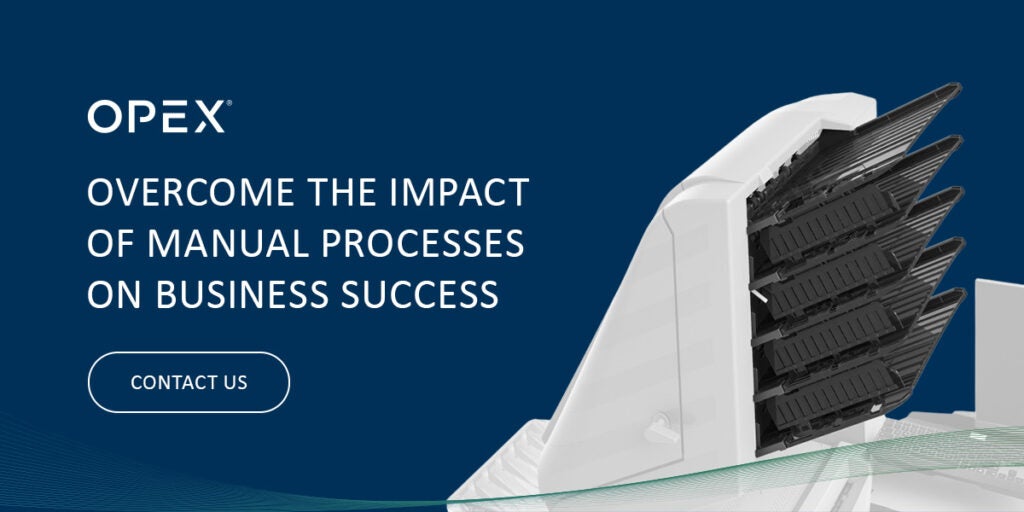60-Second Summary
Manual document management may seem manageable, but it often leads to inefficiencies, costly errors, lost productivity, and limited collaboration. Relying on manual processes slows workflows, increases human error, and makes retrieving documents difficult—especially without clear storage protocols. These issues can drive up operational costs and make collaboration across teams nearly impossible. Without real-time visibility, businesses risk uninformed decisions and stunted growth. Thankfully, automation offers a better way. With digital tools, you can streamline document handling, improve accuracy, boost security, enhance collaboration, and scale your business with confidence. Embracing automation not only saves time and money—it positions your business for lasting success.
Manual document management is common in many businesses, despite the fact that digital tools can make the process much easier. If your business manages documents manually, you likely face a range of challenges.
1. Process Inefficiencies
Manual processes are often time-consuming and demand a lot of attention from employees. Workers engaging with manual tasks lose opportunities to engage in more valuable tasks, leading to more work than your team can manage.
Every person works at a different pace. If you rely on multiple team members to complete specific tasks or operate with workflows that require one task to be completed before another can begin, you can experience efficiency gaps — workers have mountains of work while others have little to do. The result is inefficient processes that require workers to engage in repetitive, mundane, or less meaningful work.
2. Increased Error Rates in Document Management
Human error is a significant driver of manual document processing mistakes. Data entry errors alone can cost businesses trillions of dollars each year. Several factors, such as fatigue, lack of training, poor lighting, complex instructions, or pressure, can impact employee performance. While mistakes are bound to happen, minimizing their likelihood can boost your business and empower growth.
Mistakes have several adverse impacts on your business, such as:
- Cost: If a mistake impacts your resources, budget allocation, customer relationships, or any other element regarding your bottom line, you can find your business at a loss.
- Time: Mistakes can be time-consuming to address, especially when one task impacts another. For example, if you discover inaccurate report information, you’ll likely need to pull various records and documents and double-check information from multiple sources, taking time away from other tasks.
- Reputation: Customers, clients, and partners want to trust the businesses they engage with. If your business appears unreliable or inefficient, you may lose existing relationships or face more roadblocks when trying to forge new ones.
3. Data Retrieval Difficulties
Businesses lose productivity by relying on manual document retrieval. When employees spend hours a day trying to find information, they lose opportunities to engage in other tasks. Slow document retrieval leads to poor customer service, decision-making delays, and other adverse outcomes.
Teams can also experience increasing complexity if your organization lacks a specific retrieval structure. Lacking designated storage spaces or protocols for locating and replacing documents can result in employees misplacing information, potentially losing it permanently.
4. Higher Operational Costs
Another adverse outcome of maintaining manual document processes is the high cost of storing, printing, and handling paper. Physical documents require ink, printers, paper, storage units or filing cabinets, and other expenses that can quickly add up.
Finding, printing, and distributing these materials takes significant time, and losing documents can result in fines or delays that impede financial gain. Factoring in the cost of human mistakes, such as data entry errors, further propels financial losses.

5. Lowered Collaboration
Collaboration can increase efficiency, promote a sense of accomplishment, and reduce the time necessary to complete tasks. However, sharing documents and collaborating on projects is challenging when you rely on manual processes.
It takes a lot of time to print and share documents, and timetables can increase if you also lack proper digital communication tools. Teams that work in different locations can experience hefty wait times during collaboration, and without the ability to make and monitor real time updates, it can be challenging to determine which documents have your latest updates.
6. Lack of Tracking or Visibility
Locating paper documents can be challenging as-is, but improper organization and inadequate management processes reduce visibility and make tracking even more difficult. Manual document handling processes also lack the ability to monitor real-time changes or provide quick navigation.
Team members may not be aware of more updated document versions, use poor data for decision-making, or face significant delay bottlenecks from misplaced or in-use documents. Furthermore, relying on manual processes impedes your scalability. As your business grows, you need a solution that can handle growth periods, but humans alone are limited in the changes they can make to meet these demands.
7. Uninformed Decision-Making
Accurate and reliable data empowers you to identify trends and make decisions based on historical data and future predictions. Manually analyzing historical documents is time-consuming, and workers may not have the experience or understanding to spot trends, especially if they don’t know what they’re looking for. If your workers make any mistakes during this process, the decision your team makes may not be as impactful as it could have been if your team leveraged correct data.
How You Can Improve Workflow With Document Process Automation
There is a solution for navigating the challenges of manual document processes — automation. Today’s digital solutions are capable of navigating a variety of document-handling processes, including storing, analyzing, retrieving, and sharing documents. Implementing the right automated solution allows you to:
- Meet compliance: Digital automated solutions support uniform processes for document management. This uniformity can help you meet compliance and provide an easier way to navigate compliance changes when they occur.
- Strengthen security: Using digital solutions means you always have the information you need, including backups when necessary. You can leverage various security protocols to ensure authorized individuals can access documents while preventing unauthorized access from others.
- Increase adaptability: Artificial intelligence and other cutting-edge technologies empower you to scale operations or down as necessary. You can feel confident that your solution will grow with you, providing seamless customer and worker experiences.
- Reduce costs: Set rules and train your solutions to provide accurate outputs. These machines and processes can enhance accuracy and reliability while reducing time spent on each task, delivering cost savings all around.
- Enhance collaboration: Digital solutions make it easier to share documents and allow you to make real-time updates. Your team can enjoy the simplicity of using digital tools to collaborate on projects and experience the convenience of accessing documents wherever and whenever they need them.
- Inform decisions: You can use digital solutions to pull specific reports, request industry predictions, and employ tactics to compare historical data with current information.
Overcome the Impact of Manual Processes on Business Success
OPEX® is the next generation of automation. The OPEX team engineers automated solutions to address your business’s most pressing challenges. OPEX document and mail automation allows businesses to increase efficiency, cut costs, reduce manual labor, and gain a competitive edge through innovative technology and scalable operations. For help finding the right automated solution for your business, connect with an OPEX representative today.
Other Resources You Might Find Helpful
GTL Implements Automation & AI to Transform the Claims Handling Process
Portsmouth, VA Treasurer’s Office Goes from Cost Center to Revenue Center
Tectel SA Digitizes Medical Records for a Major Hospital with the Document Imaging Solution From OPEX®
Scan2Archive Positioned To Embrace A Digital Future With The Solution From OPEX® And Smartech
Taking on Wisconsin Department of Transportation DMV’s Digital Transformation
Legastat: When Flatbed Scanning is NOT Enough
OPEX® Falcon+® RED One-touch Scanning
Timaru District Council (TDC) Launches into a Digital World
Enhancing the Digitization Process at Iron Mountain Government Solutions
Medical Record Scanning Demonstration with the OPEX Falcon+ Scanner
NEXT LEVEL AUTOMATION
Unlock Operational Efficiency with OPEX
OPEX is powering the future of automation. Contact us to learn more about how our vertically integrated automated solutions can help take your business to new heights.
